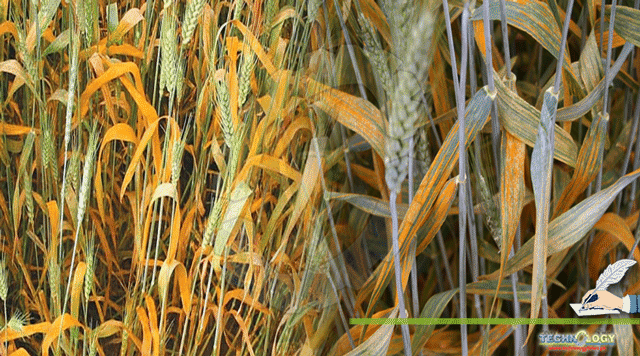Wheat is the most widely grown crop in the world. Wheat is the major staple food crop in Pakistan and cultivated on the largest acreages.

Wheat
Its importance is evident as it constitutes 60% of the daily diet of common man in Pakistan. Approximately one sixth of the total arable land in the world is under wheat. It is most demanded food grain and its production leads all crops, including rice, maize and potatoes. With per capita consumption of about 125 kg it occupies a central position in agricultural policies of the government.
Climatic Conditions
The optimum growing temperature is about 25°C, with minimum and maximum growth temperatures of 3° to 4°C and 30° to 32°C, respectively. Wheat is adapted to a broad range of moisture conditions and can be grown in most locations where precipitation ranges from 250 to 1750 mm.
Classification
Classification into spring or winter wheat is common and traditionally refers to the season during which the crop is grown. For winter wheat, heading is delayed until the plant experiences a period of cold winter temperatures (0° to 5°C) while Spring wheat usually planted in the spring (can be sown in autumn in countries like Pakistan that experience mild winters) .
Cropping Systems
In Pakistan, wheat is grown in different cropping systems, such as; cotton wheat, rice wheat, sugarcane wheat, maize wheat, fallow wheat. Mostly Cotton-Wheat and Rice-Wheat systems are adopted.
Diseases
Rust Issues on Wheat
Rust diseases possess the ability to spread and travel long distances by dispersal of windborne spores and can rapidly develop under optimal weather conditions.Wheat is affected by three different types of rust diseases
1. Stripe/Yellow Rust
2. Stem Rust
3. Leaf Rust
Yellow/stripe Rust of Wheat
Yellow/stripe rust of wheat, caused by Puccinia striiformis Westendorf f. sp. tritici, is an important disease and severe infestation. Weather conditions higher humidity with low temperatures witnessed after decades has also created an atmosphere conducive for pest infestation. It also occurs in the central and northern districts of Khyber-Pakhtunkhwa from mid-February to mid-March. In Northern areas rust can occur even in late April. This rust was mainly affecting wheat in central, northern Punjab and KP but in recent years it started affecting wheat crop in Sindh and southern Punjab due to climate and pathogen adaptability.
Leaf Rust of Wheat
Leaf rust or brown rust is the most common and widespread rust of wheat across the world. It is caused by Puccinia triticina . It attacks mostly the leaf blades, and under more favorable conditions can also attack leaf sheaths and glumes. Leaf rust occurs mostly in Punjab particularly in warmer areas. This can also occur in central districts like Nowshera, Mardan and Swabi.
Stem Rust of Wheat
The stem, black, and cereal rusts are caused by the fungus Puccinia graminis.Across the world, black rust or stem rust has been one of the most devastating diseases of cereal crops known to cause famines, and economic as well as political crises particularly in south Asia that led to the inception of the Green Revolution.
In the last several years, wheat rusts emerged as a major threat to production, but nothing concrete as done to control this menace. International Maize and Wheat Improvement Centre (CIMMYT in its recent alert has warned that the spread of yellow rust disease might evolve in new forms. Country Representative of CIMMYT in Pakistan was of the view that when weather is good for wheat production, it is equally good for wheat yellow rust attack. He continued to say that damage to wheat crop could be seen if effective measures were not taken against its attack.
Recommendations
A well-thought-out disease-management program, including best management practices, proper seed protection and selection and fungicide applications using multiple modes of action, should be implemented to sustainably manage diseases. The following Crop Science solutions are valuable tools to consider for your program.
Use of Fungicides
If susceptible varieties are grown, worldwide effective fungicides application at appropriate growth stage play an important role in rust management, however, fungicides should be regarded as secondary option and not a substitute for resistant varieties. Experts recommend the use of fungicides at least on the patches where the disease is found. They say any of the three fungicides Nativo, Tilt and Electis Super is equally useful for controlling the disease.
Sow New Seed Variety
Wheat growers should sow a new seed variety after a couple of years. This is important as repeated sowing allows the Yellow Rust to overcome the plant’s resistance to the disease.
Disease Resistant Varieties
Breeders and pathologists have given priority to develop disease resistant and high yielding varieties in order to cope with threats created by ever changing rust races by using approaches like durable resistance. Department of Agriculture (USDA), CIMMYT and Pakistani scientists have resulted in the successful testing and release of 35 highly productive rust resistant wheat varieties that are capable of surviving even the destructive Ug-99 wheat fungal disease a stem rust disease which is not yet reached Pakistan but was reported from neighbouring country like Iran.
Cultural practices
Disease-free seed gives seedlings a good start. Good weed control preplant, at planting and throughout the growing season also helps protect against disease and other pests.
Seed treatments
Seed treatments protect seed and young plants from disease and other threats to plant health and yield. Areas commonly infested with rust also will need a foliar fungicide treatment to provide protection beyond the seedling growth stage.
Authors : Binish Ali, Aftab, Syed Zeeshan Haider, Fayyaz Hassan and supervised by Dr. Haron Zamaan Khan Department of Agronomy Unversity of Agriculture Faisalabad